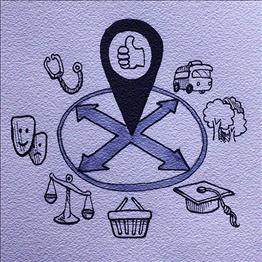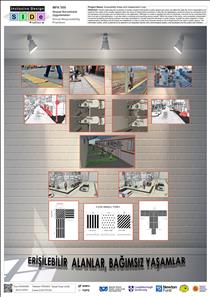Loading
Accessible Areas, Independent Lives

DESIGNED BY:
İrem Özdemir, Merve Genç, Mehmet Yönden, İsmail Turan Acer, Canan Çam Yücel (SDFB)
INTRODUCTION:
Independence is a fundamental need of human beings. Undoubtedly, we all desire to be independent, not being limited with restrictions, and above all, to continue our lives without depending on someone else. Although we may not always be aware of how vital being independent is for us, this issue holds vital importance, especially for individuals with disabilities. Our project aims at providing individuals with disabilities the right to live independently and move freely in the cities.
The challenges faced by individuals with disabilities during their urban transportation were identified in the first phase of our study. Our interviews with the NGO design partner have guided our research on identifying these problems and enabled us to reach major problematic areas. The difficulties in determining the direction at intersection points in the city, deciding on the flow of direction of stairs on escalators, and similarly, not being able to determine the direction of the subway train while waiting at the subway platforms could be listed among the key problem areas encountered by disabled persons. It was found out that the difficulty in determining the direction itself is the root cause of these problems we identified, and therefore, our project has focused on the concept of 'Direction' to recommend a solution for this issue.
DESIGN FOCUS:
The solution aimed at facilitating the independent movement of persons with visual disabilities by improving the existing tactile paving system in current use. Thus, a new guide track system was developed, which was named as 'multangular surface'. Thanks to the new guide track system, a new approach has been developed that will provide orientation in advance with 45 degrees instead of 90 degrees of turn due to using the existing straight guide track placed horizontally to orientate the person with visual disability. This approach was discussed with the NGO design partner, and it was concluded that it could be useful. Our design team also learned how the existing tactile paving system works along with the widely used white cane techniques through these discussions. In this way, with the help of the multangular surface that we developed, some layout suggestions were also proposed to facilitate orientation in certain public spaces.
As a result of the meetings with the course tutors in the following stages of the project, it was decided to focus on and develop a solution proposal on places in the city, where all pedestrians, and therefore, all persons with visual disabilities have trouble frequently. Arrangement of sidewalks is one of those challenges, and research was carried out to gather more information on this issue. The NGO design partner also reflected that sidewalk arrangements in our country, especially in Istanbul, do not follow a standard. Unfortunately, it was observed that the tactile paving on sidewalks, generally referred to as “yellow lines”, cannot function in our country due to the obstacles placed around these lines. Normally persons with visual disabilities should be able to move over these tactile/guiding surfaces with their white canes; however, it became evident that they walk along the edge of the tactile paving because of the inappropriate sidewalk arrangements, as well as the obstacles placed over them.
In addition to these findings, it was decided that the developed navigation system would benefit an integrated technological module to facilitate the independent movement of persons with visual disabilities in urban areas. For this purpose, an information button was designed to support persons who require information to find a location, regardless of having a disability or not. When the user presses the button and says where they want to go, the system senses and processes the audio message with its internal software, and then, can guide the user by presenting the required information. The system aims to build a support mechanism that will aid persons with visual disabilities who face challenges during their independent movement in urban areas. These devices will be placed at specific locations within the city, especially at public transportation stations. By this means, a unique support system will be built, which can be used by all.
CONCLUSION:
Based on the concept of independent movement, the project we have developed made it clear that even the good systems might fail because of the underlying issues caused by wrong applications. Within the scope of our project, sample layout arrangements of tactile paving, which can be used in public spaces and urban systems for persons with visual disabilities, were created. In addition to the new tactile guiding arrangements and the information button system, our project has another output, a guiding document titled "Guideline of Standards for Persons with Visual Disabilities" to assist designers accordingly.
İrem Özdemir, Merve Genç, Mehmet Yönden, İsmail Turan Acer, Canan Çam Yücel (SDFB)
INTRODUCTION:
Independence is a fundamental need of human beings. Undoubtedly, we all desire to be independent, not being limited with restrictions, and above all, to continue our lives without depending on someone else. Although we may not always be aware of how vital being independent is for us, this issue holds vital importance, especially for individuals with disabilities. Our project aims at providing individuals with disabilities the right to live independently and move freely in the cities.
The challenges faced by individuals with disabilities during their urban transportation were identified in the first phase of our study. Our interviews with the NGO design partner have guided our research on identifying these problems and enabled us to reach major problematic areas. The difficulties in determining the direction at intersection points in the city, deciding on the flow of direction of stairs on escalators, and similarly, not being able to determine the direction of the subway train while waiting at the subway platforms could be listed among the key problem areas encountered by disabled persons. It was found out that the difficulty in determining the direction itself is the root cause of these problems we identified, and therefore, our project has focused on the concept of 'Direction' to recommend a solution for this issue.
DESIGN FOCUS:
The solution aimed at facilitating the independent movement of persons with visual disabilities by improving the existing tactile paving system in current use. Thus, a new guide track system was developed, which was named as 'multangular surface'. Thanks to the new guide track system, a new approach has been developed that will provide orientation in advance with 45 degrees instead of 90 degrees of turn due to using the existing straight guide track placed horizontally to orientate the person with visual disability. This approach was discussed with the NGO design partner, and it was concluded that it could be useful. Our design team also learned how the existing tactile paving system works along with the widely used white cane techniques through these discussions. In this way, with the help of the multangular surface that we developed, some layout suggestions were also proposed to facilitate orientation in certain public spaces.
As a result of the meetings with the course tutors in the following stages of the project, it was decided to focus on and develop a solution proposal on places in the city, where all pedestrians, and therefore, all persons with visual disabilities have trouble frequently. Arrangement of sidewalks is one of those challenges, and research was carried out to gather more information on this issue. The NGO design partner also reflected that sidewalk arrangements in our country, especially in Istanbul, do not follow a standard. Unfortunately, it was observed that the tactile paving on sidewalks, generally referred to as “yellow lines”, cannot function in our country due to the obstacles placed around these lines. Normally persons with visual disabilities should be able to move over these tactile/guiding surfaces with their white canes; however, it became evident that they walk along the edge of the tactile paving because of the inappropriate sidewalk arrangements, as well as the obstacles placed over them.
In addition to these findings, it was decided that the developed navigation system would benefit an integrated technological module to facilitate the independent movement of persons with visual disabilities in urban areas. For this purpose, an information button was designed to support persons who require information to find a location, regardless of having a disability or not. When the user presses the button and says where they want to go, the system senses and processes the audio message with its internal software, and then, can guide the user by presenting the required information. The system aims to build a support mechanism that will aid persons with visual disabilities who face challenges during their independent movement in urban areas. These devices will be placed at specific locations within the city, especially at public transportation stations. By this means, a unique support system will be built, which can be used by all.
CONCLUSION:
Based on the concept of independent movement, the project we have developed made it clear that even the good systems might fail because of the underlying issues caused by wrong applications. Within the scope of our project, sample layout arrangements of tactile paving, which can be used in public spaces and urban systems for persons with visual disabilities, were created. In addition to the new tactile guiding arrangements and the information button system, our project has another output, a guiding document titled "Guideline of Standards for Persons with Visual Disabilities" to assist designers accordingly.
Please login to post comments
